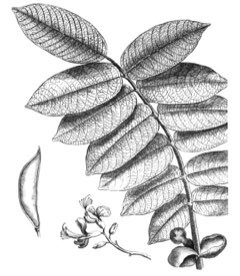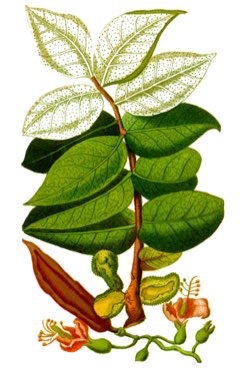 |
|
http://www.edibleplants.org |
 |
| http://www.edibleplants.org |
Translate this page:
Summary
Commonly found in South America particularly in Brazil, Venezuela, and the Guyanas, Swartzia panacoco is a tree growing up to 30 m tall with a straight and cylindrical, low-buttressed bole. This species is not edible. Bark decoction induces sweating. The bark contains a balsamic red resin. The wood, known as Coracao de Negro, is used for high class furniture, cabinet making, musical instruments, turnery, sculpture, flooring, etc.
Physical Characteristics

 Swartzia panacoco is an evergreen Tree growing to 25 m (82ft) by 25 m (82ft) at a medium rate.
Swartzia panacoco is an evergreen Tree growing to 25 m (82ft) by 25 m (82ft) at a medium rate.
See above for USDA hardiness. It is hardy to UK zone 10.
It can fix Nitrogen.
Suitable for: light (sandy) and medium (loamy) soils and prefers well-drained soil. Suitable pH: mildly acid and neutral soils. It cannot grow in the shade. It prefers moist soil.
UK Hardiness Map
US Hardiness Map
Synonyms
Robinia panacoco Aubl. Robinia tomentosa Fisch. Swartzia polyanthera Steud. Swartzia similis Benoist
Plant Habitats
Edible Uses
References More on Edible Uses
Medicinal Uses
Plants For A Future can not take any responsibility for any adverse effects from the use of plants. Always seek advice from a professional before using a plant medicinally.
Diaphoretic
A decoction of the bark is drunk as a sudorific[348 , 739 ].
References More on Medicinal Uses
The Bookshop: Edible Plant Books
Our Latest books on Perennial Plants For Food Forests and Permaculture Gardens in paperback or digital formats.

Edible Tropical Plants
Food Forest Plants for Hotter Conditions: 250+ Plants For Tropical Food Forests & Permaculture Gardens.
More

Edible Temperate Plants
Plants for Your Food Forest: 500 Plants for Temperate Food Forests & Permaculture Gardens.
More

More Books
PFAF have eight books available in paperback and digital formats. Browse the shop for more information.
Shop Now
Other Uses
Furniture Resin Wood
Other Uses: The bark contains a balsamic red resin[348 ]. The heartwood is a deep, dark brown with lighter, thin streaks; it is clearly demarcated from the 3 - 8cm wide band of light yellow sapwood. The texture is medium; the grain straight or slightly interlocked. The wood is very heavy; very hard; very strong; very elastic; very durable, being very resistant to fungi, dry wood borers and termites. It seasons slowly, with a high risk of checking but only a slight risk of distortion; once dry it is poorly to moderately stable in service. It is a very hard wood and has a fairly high blunting effect - stellite-tipped and tungsten carbide tools are recommended; nailing and screwing are good, but require pre-boring; gluing is poor. A high quality, very strong, durable and attractive timber, its use is limited mainly by the small size of heartwood obtained from the logs. It is used for purposes such as high class furniture, cabinet making, musical instruments of various types, turnery, sculpture, flooring, panelling, wooded goods, items such as arches that require forming; veneer etc[848 ].
Special Uses
Nitrogen Fixer
References More on Other Uses
Cultivation details
There are conflicting reports on whether or not this tree has a symbiotic relationship with certain soil bacteria, so it is unclear as to whether this tree fixes atmospheric nitrogen[755 ].
References Carbon Farming Information and Carbon Sequestration Information
Temperature Converter
Type a value in the Celsius field to convert the value to Fahrenheit:
Fahrenheit:
The PFAF Bookshop
Plants For A Future have a number of books available in paperback and digital form. Book titles include Edible Plants, Edible Perennials, Edible Trees,Edible Shrubs, Woodland Gardening, and Temperate Food Forest Plants. Our new book is Food Forest Plants For Hotter Conditions (Tropical and Sub-Tropical).
Shop Now
Plant Propagation
Seed -
Other Names
If available other names are mentioned here
Native Range
SOUTHERN AMERICA: French Guiana, Guyana, Suriname, Venezuela (Amazonas, Bolívar), Brazil
Weed Potential
Right plant wrong place. We are currently updating this section.
Please note that a plant may be invasive in one area but may not in your area so it's worth checking.
Conservation Status
IUCN Red List of Threatened Plants Status : Status: Least Concern

Growth: S = slow M = medium F = fast. Soil: L = light (sandy) M = medium H = heavy (clay). pH: A = acid N = neutral B = basic (alkaline). Shade: F = full shade S = semi-shade N = no shade. Moisture: D = dry M = Moist We = wet Wa = water.
Now available:
Food Forest Plants for Mediterranean Conditions
350+ Perennial Plants For Mediterranean and Drier Food Forests and Permaculture Gardens.
[Paperback and eBook]
This is the third in Plants For A Future's series of plant guides for food forests tailored to
specific climate zones. Following volumes on temperate and tropical ecosystems, this book focuses
on species suited to Mediterranean conditions—regions with hot, dry summers and cool, wet winters,
often facing the added challenge of climate change.
Read More
Expert comment
Author
(Aubl.) R.S.Cowan
Botanical References
Links / References
For a list of references used on this page please go here
A special thanks to Ken Fern for some of the information used on this page.
Readers comment
| Add a comment |
|
If you have important information about this plant that may help other users please add a comment or link below. Only comments or links that are felt to be directly relevant to a plant will be included. If you think a comment/link or information contained on this page is inaccurate or misleading we would welcome your feedback at [email protected]. If you have questions about a plant please use the Forum on this website as we do not have the resources to answer questions ourselves.
* Please note: the comments by website users are not necessarily those held by PFAF and may give misleading or inaccurate information.
To leave a comment please Register or login here All comments need to be approved so will not appear immediately.
|
Subject : Swartzia panacoco
|
|
|
|